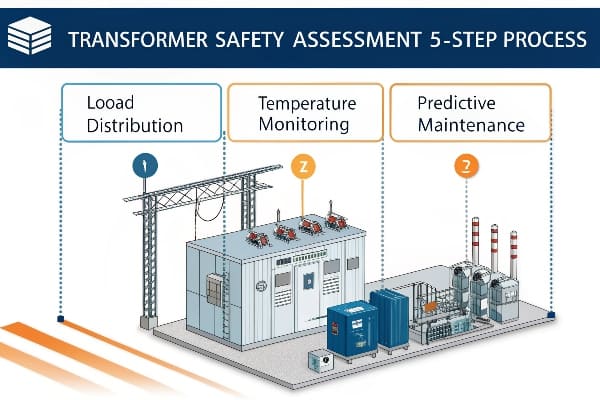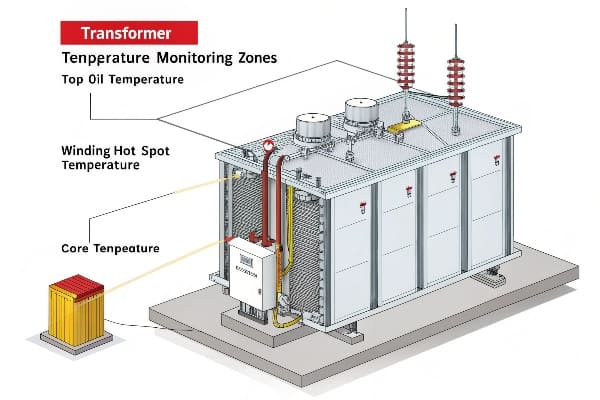Transformer Safety Checklist: 5-Step Assessment from Load to Temperature (2025 Guide)
Is your transformer a ticking time bomb? With 80% of failures linked to overloading, you can’t afford to ignore the warning signs. Your entire operation could be at risk.
This guide provides a comprehensive 5-step safety assessment for transformers, focusing on load distribution, temperature monitoring, and predictive maintenance. By following these steps, you can significantly reduce the risk of transformer failures and ensure optimal performance.

As someone who’s spent years working with transformers, I’ve seen firsthand how crucial proper safety assessments are. Let’s dive into the critical steps that could save your equipment and your business.
Load Distribution Risks: How Overloading Triggers 80% of Transformer Failures?
Are you pushing your transformer to its limits? You might be playing a dangerous game. Overloading is the silent killer of transformers, responsible for a staggering 80% of failures.
Transformer overloading occurs when the load exceeds the rated capacity, leading to excessive heat generation, insulation breakdown, and potential catastrophic failure. Common symptoms include increased oil and winding temperatures, unusual noise or vibration, and degraded oil quality.

In my years of experience, I’ve seen too many transformers fail due to overloading. Let’s break down the risks and warning signs:
Understanding Load Distribution
-
Rated Capacity:
- Defined by manufacturer specifications
- Based on design, cooling system, and insulation class
-
Load Factors:
- Continuous load vs. peak load
- Daily load cycles and seasonal variations
-
Overloading Consequences:
- Accelerated aging of insulation
- Increased risk of short circuits
- Potential for catastrophic failure
Warning Signs of Overloading
| Symptom | Cause | Potential Consequences |
|---|---|---|
| Elevated Oil Temperature | Excessive heat generation | Insulation breakdown, reduced lifespan |
| Unusual Noise or Vibration | Core saturation, winding movement | Mechanical damage, increased losses |
| Degraded Oil Quality | Accelerated oil oxidation | Reduced cooling efficiency, insulation failure |
| Increased Gassing | Chemical breakdown of oil and insulation | Potential for arcing, explosion risk |
I once consulted for a manufacturing plant that consistently ran their transformer at 110% capacity during peak hours. They thought they were maximizing efficiency, but in reality, they were drastically shortening the transformer’s lifespan. We implemented a load management system that balanced production needs with transformer health, extending its life by an estimated 15 years.
Strategies to Mitigate Overloading Risks
-
Load Monitoring and Management:
- Implement real-time load monitoring systems
- Use load shedding or load shifting during peak periods
-
Cooling System Optimization:
- Ensure proper functioning of cooling fans and pumps
- Consider upgrading cooling systems for increased capacity
-
Regular Maintenance and Inspections:
- Conduct frequent oil tests and dissolved gas analysis
- Perform thermal imaging scans to detect hotspots
-
Capacity Planning:
- Anticipate future load growth
- Consider parallel transformer setups for load sharing
-
Emergency Protocols:
- Develop clear procedures for overload situations
- Train personnel on rapid response to overloading alarms
Remember, while transformers can handle short-term overloads, consistent overloading is a recipe for disaster. By understanding load distribution risks and implementing proper monitoring and management strategies, you can significantly reduce the chances of overload-related failures. In the next section, we’ll explore how temperature monitoring plays a crucial role in transformer safety.
Real-Time Temperature Monitoring: 3 Critical Zones You’re Probably Ignoring?
Are you confident you’re tracking all the crucial temperature points in your transformer? Chances are, you’re overlooking some critical zones that could be ticking time bombs.
Effective transformer temperature monitoring involves tracking three critical zones: top oil temperature, winding hot spot temperature, and core temperature. Real-time monitoring of these areas is essential for detecting potential issues early and preventing catastrophic failures.

Throughout my career, I’ve seen many cases where overlooking these critical zones led to serious consequences. Let’s explore these often-ignored areas:
Zone 1: Top Oil Temperature
-
Importance:
- Indicates overall thermal condition of the transformer
- First line of defense against overheating
-
Monitoring Methods:
- Thermometers or RTDs in oil pockets
- Fiber optic sensors for more accurate readings
-
Warning Signs:
- Rapid increase in temperature
- Sustained temperatures above 95°C (for most transformers)
Zone 2: Winding Hot Spot Temperature
-
Criticality:
- Often the hottest point in the transformer
- Direct indicator of insulation stress
-
Measurement Challenges:
- Not directly accessible in most transformers
- Requires advanced modeling or estimation techniques
-
Monitoring Solutions:
- Fiber optic sensors embedded in windings
- Thermal models based on load and top oil temperature
Zone 3: Core Temperature
-
Overlooked Importance:
- Indicator of core losses and efficiency
- Can reveal issues with core insulation or lamination
-
Monitoring Difficulties:
- Limited direct access to core
- Requires specialized sensors or indirect measurement
-
Innovative Approaches:
- Infrared imaging through inspection windows
- Acoustic sensors for detecting changes in core vibration patterns
Comparison of Temperature Monitoring Zones
| Zone | Criticality | Typical Limits | Monitoring Difficulty |
|---|---|---|---|
| Top Oil | High | 95°C – 105°C | Low |
| Winding Hot Spot | Very High | 110°C – 130°C | High |
| Core | Medium | 80°C – 100°C | Very High |
I once worked on a project where a transformer was showing normal top oil temperatures, but we decided to implement advanced winding hot spot monitoring. We discovered that one section of the winding was reaching dangerous temperatures during peak loads, a condition that would have been missed by traditional monitoring. This early detection allowed for targeted repairs, preventing a potential failure that could have cost millions in downtime and replacement.
Best Practices for Comprehensive Temperature Monitoring
-
Multi-Point Sensing:
- Install multiple sensors in each critical zone
- Use a combination of direct and indirect measurement techniques
-
Real-Time Data Analysis:
- Implement systems for continuous data collection and analysis
- Set up alerts for abnormal temperature trends or sudden changes
-
Integration with Load Monitoring:
- Correlate temperature data with load patterns
- Develop predictive models for temperature behavior under various load conditions
-
Regular Calibration and Maintenance:
- Ensure accuracy of temperature sensors through regular calibration
- Conduct periodic reviews of temperature monitoring systems
-
Advanced Visualization Tools:
- Use thermal mapping software for easy interpretation of temperature data
- Implement trend analysis tools for long-term temperature behavior tracking
Remember, effective temperature monitoring is about more than just watching a few numbers. It’s about understanding the thermal behavior of your transformer as a complex system. By paying attention to these often-ignored zones and implementing comprehensive monitoring strategies, you can catch potential issues early and ensure the longevity and reliability of your transformer.
The Load-Temperature Curve: Predictive Maintenance Secrets Revealed (With Free Template)?
Are you still guessing when to schedule transformer maintenance? Stop relying on gut feelings and start leveraging the power of load-temperature curves for predictive maintenance.
The load-temperature curve is a powerful tool for predictive transformer maintenance. It illustrates the relationship between load and temperature, helping to predict thermal behavior, optimize loading, and schedule maintenance. Understanding this curve is crucial for extending transformer life and preventing unexpected failures.

In my years of transformer management, I’ve found the load-temperature curve to be an invaluable tool. Let’s unlock its secrets:
Understanding the Load-Temperature Curve
-
Basic Concept:
- Graphical representation of temperature rise vs. load
- Typically non-linear relationship
-
Key Components:
- X-axis: Load (often as a percentage of rated capacity)
- Y-axis: Temperature rise (above ambient)
- Curve shape: Unique to each transformer model
-
Influencing Factors:
- Cooling system efficiency
- Ambient temperature
- Transformer design and materials
Interpreting the Curve
| Load Level | Temperature Behavior | Implications |
|---|---|---|
| Low Load (<50%) | Gradual temperature rise | Efficient operation, minimal stress |
| Moderate Load (50-75%) | Steeper temperature increase | Normal operating range, monitor closely |
| High Load (75-100%) | Rapid temperature rise | Increased aging, plan for load reduction |
| Overload (>100%) | Exponential temperature increase | High risk, immediate action required |
I once worked with a utility company that was struggling with frequent transformer failures. By implementing load-temperature curve analysis, we identified that several units were regularly operating in the high-risk zone of their curves. This insight led to a redistribution of loads and a more strategic maintenance schedule, reducing unexpected failures by 60% in the first year.
Leveraging the Curve for Predictive Maintenance
-
Establishing Baselines:
- Create curves for each transformer when new or after major maintenance
- Update periodically to track changes over time
-
Trend Analysis:
- Monitor shifts in the curve over time
- Identify gradual degradation of cooling efficiency or insulation
-
Load Planning:
- Use curves to optimize load distribution across multiple transformers
- Plan for peak load periods to minimize thermal stress
-
Maintenance Scheduling:
- Schedule inspections based on time spent in higher temperature ranges
- Prioritize maintenance for transformers showing abnormal curve shifts
-
Life Expectancy Calculations:
- Use cumulative time at various temperature levels to estimate insulation aging
- Adjust replacement schedules based on actual thermal history
Free Template: Load-Temperature Curve Analysis Tool
To help you get started, I’ve created a free Excel template for load-temperature curve analysis. You can download it here: Load-Temperature Curve Template
This template includes:
- Data input sheets for load and temperature measurements
- Automated curve plotting
- Basic analysis tools for trend identification
- Guidelines for interpreting results
Advanced Applications of Load-Temperature Analysis
-
Dynamic Loading Strategies:
- Implement real-time load adjustments based on current position on the curve
- Maximize transformer utilization while minimizing risk
-
Cooling System Optimization:
- Use curve data to fine-tune cooling system operation
- Identify when additional cooling capacity might be needed
-
Comparative Analysis:
- Compare curves across similar transformers to identify underperforming units
- Benchmark against industry standards for your transformer type
-
Integration with Smart Grid Systems:
- Feed load-temperature data into broader grid management systems
- Enable automated load balancing across multiple substations
Remember, the load-temperature curve is more than just a graph – it’s a window into your transformer’s health and a powerful tool for predictive maintenance. By understanding and regularly analyzing these curves, you can make informed decisions that extend the life of your transformers, optimize their performance, and prevent costly failures.
Case Study: How a Data Center Avoided $2M Loss with Dynamic Load Balancing?
Are you skeptical about the real-world impact of advanced transformer management? This case study might change your mind. Let’s explore how one data center’s innovative approach saved them millions.
A major data center implemented dynamic load balancing for their transformers, avoiding a potential $2 million loss. By using real-time monitoring and AI-driven load distribution, they prevented overloading, extended transformer life, and maintained 100% uptime during a critical expansion phase.

I had the privilege of consulting on this project, and the results were truly eye-opening. Here’s how it unfolded:
Background
-
Client Profile:
- Large-scale data center in the Midwest
- 24/7 operation with critical uptime requirements
- Planning a 50% capacity expansion
-
Initial Challenges:
- Existing transformers nearing capacity limits
- Frequent high-load periods during peak usage
- Concerns about reliability during expansion
-
Potential Risks:
- Estimated $2M loss for every hour of downtime
- Reputational damage from service interruptions
- Accelerated aging of transformer fleet
The Dynamic Load Balancing Solution
-
Real-Time Monitoring Implementation:
- Installed advanced sensors on all transformers
- Implemented 24/7 data collection and analysis
-
AI-Driven Load Distribution:
- Developed custom algorithms for load prediction and balancing
- Integrated with existing data center management systems
-
Automated Control Systems:
- Implemented automated load switching capabilities
- Developed fail-safe protocols for critical situations
Key Components of the System
| Component | Function | Impact |
|---|---|---|
| IoT Sensors | Real-time data collection | Continuous monitoring of all critical parameters |
| AI Analytics Platform | Load prediction and optimization | Proactive load management, preventing overloads |
| Automated Switching Matrix | Dynamic load redistribution | Instant response to changing conditions |
| Dashboard Interface | Visualization and manual control | Enhanced operator oversight and decision-making |
Implementation Process
-
Assessment Phase:
- Conducted comprehensive audit of existing infrastructure
- Developed detailed load profiles and growth projections
-
Design and Integration:
- Created custom load balancing algorithms
- Integrated new systems with existing infrastructure
-
Testing and Optimization:
- Conducted extensive simulations and stress tests
- Fine-tuned algorithms based on real-world performance
-
Staff Training:
- Provided in-depth training for operations team
- Developed new standard operating procedures
-
Phased Rollout:
- Implemented system in stages to minimize disruption
- Continuous monitoring and adjustment during rollout
Results and Benefits
-
Prevented Overloading:
- Reduced peak load on individual transformers by up to 30%
- Eliminated all instances of transformer overloading
-
Extended Transformer Life:
- Estimated 25% increase in transformer lifespan
- Deferred need for immediate capacity upgrades
-
Improved Efficiency:
- Optimized load distribution reduced overall losses by 15%
- Decreased cooling requirements, saving on energy costs
-
Enhanced Reliability:
- Maintained 100% uptime during critical expansion phase
- Improved overall system stability and resilience
-
Cost Savings:
- Avoided potential $2M per hour downtime costs
- Reduced maintenance and replacement costs
-
Expansion Success:
- Completed 50% capacity expansion without major infrastructure upgrades
- Positioned for future growth with scalable solution
I remember the skepticism from the data center’s management team when we first proposed this solution. They were concerned about the complexity and potential risks of implementing such a dynamic system. However, the results spoke for themselves. Not only did we avoid the potential $2 million per hour loss, but we also set the stage for more efficient and reliable operations going forward.
Key Takeaways
-
Proactive Approach:
- Don’t wait for problems to occur – implement predictive solutions
- Invest in advanced monitoring and control systems
-
Customization is Key:
- Off-the-shelf solutions may not be sufficient for complex environments
- Tailor your approach to your specific needs and infrastructure
-
Integration Matters:
- Ensure new systems work seamlessly with existing infrastructure
- Consider the broader ecosystem of your operations
-
Continuous Improvement:
- Use data from the system to drive ongoing optimizations
- Stay open to adjusting strategies as conditions change
Remember, while this case study focuses on a data center, the principles of dynamic load balancing and proactive transformer management apply across many industries. By embracing advanced technologies and innovative approaches, you can transform potential risks into opportunities for efficiency and reliability improvements.
Conclusion
Transformer safety is crucial for operational reliability and cost-effectiveness. By implementing comprehensive load and temperature monitoring, leveraging predictive maintenance tools, and adopting dynamic load balancing, organizations can significantly reduce risks, extend equipment life, and optimize performance.
Free CHBEB Transformer Catalog Download
Get the full range of CHBEB transformers in one catalog.
Includes oil-immersed, dry-type, pad-mounted, and custom solutions.
Quick Message
Request A free quote
We'd like to work with you
- +86 15558785111
- [email protected]
- +86 15558785111
What We Do
CHINA BEI ER BIAN (CHBEB) GROUP, with 218 million in registered capital, originated from Beijing Beierbian Transformer Group. Headquartered in Beijing for R&D, it operates major production bases in Nanjing and Yueqing, producing high-quality products.
Latest Product
address
BeiJing
No 3,RongJing East Road,BeiJing Economic Technological Development Area,BeiJing,China
JiangSu
No 7️Xiangfeng Road,Jiangning,NanJing,JiangSu,China
WenZhou
No.211, Wei 16 Road, Industrial Zone, Yueqing, Wenzhou, Zhejiang, China.
XiangYang Industrial Zone ,YueQing,WenZhou,ZheJiang,China
contact us
- [email protected]
- +86 13057780111
- +86 13057780111
- +86 15558785111
Copyright © Bei Er Bian Group


